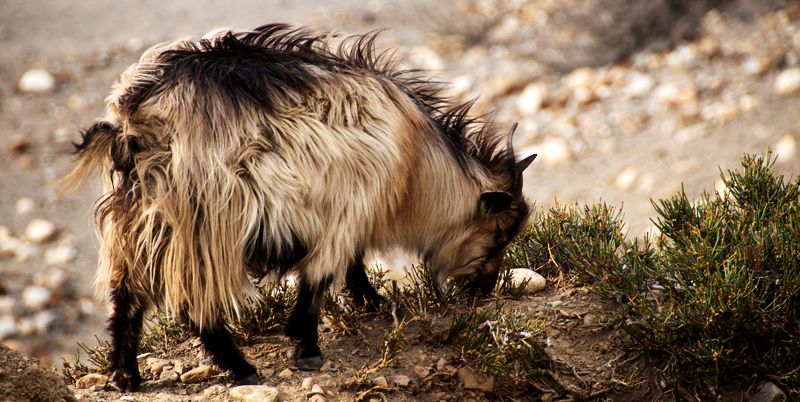Despite facing stiff competition from far inferior (and cheaper) reproductions, Nepali pashmina has stood the test of time and persevered. Now, after being rebranded as Chyangra Pashmina, it is up to the industry to innovate and maintain its fabled quality.
The image of a lone mountain goat, high in the Himalayas, is perhaps the farthest one can get from luxury. But it's from the soft inner coat of the chyangra, as the goat is locally called, that we acquire the highly coveted and deluxe pashmina fibre. This very fine wool, measuring around 13 to 17 microns in diameter, is collected from the fleece of these animals that live more than 3000 meters above sea level. The outer coat is discarded and only the finest inner material, also known as the 'Diamond fibre', is used. This is what makes Nepali pashmina an internationally renowned and coveted luxury item.
The fibre for pashmina wool is collected every spring when the animal is moulting. Normally, a comb is raked through the fleece of the goat and tufts of hair are removed. They are subsequently sorted and de-haired to remove any coarse outer fur and then washed. The fibre is eventually spun into a yarn and woven into various products, a few of which are scarves, shawls and cardigans. Natural pashmina is usually found in shades of grey, blue or white but can be dyed into any colour.
Despite the decline in demand due to tough competition from cheaper foreign counterparts (that are often mixed with polyester and viscose), Nepalese pashmina still holds a status of its own. Perhaps the most important feature of Nepali pashmina is that it is completely authentic and unadulterated. "Pure pashmina has a certain spring to it that can never be found in any other blend of fibres," says Sunil Shrestha of Nepal Pashmina Industries. In order to preserve the authenticity of Nepalese pashmina and combat the effect of cheap imitations, the Nepalese government and pashmina producers have jointly registered a trademark for the wool. Nepalese pashmina is henceforth to be referred to as 'Chyangra Pashmina'.
This trademark, which has already been registered in almost 40 countries, is not only an assurance of the quality of raw materials used but also guarantees the process, production environment, processing and use of skilled manpower during manufacture.
Chyangra pashmina is generally handmade, another one of its valuable features, which ensures that each piece is one of a kind. While these products are traditionally plain and monochromatic, pashmina producers are now starting to use methods such as ikat and tie-dye techniques to colour and print designs onto the fabric. "Our Dhaka patterns are getting quite popular and our western and Nepali fusion designs are gaining pace as well," says Shrestha. Similarly, other production houses too are introducing fresh designs to attract new clients.
While the rebranding may, to some extent, have brought the industry out of a decade long slump, the real challenge lies in maintaining the brand and its quality. That being said, pashmina is still one of Nepal's biggest exports and a covetable luxury, one that cannot be imitated with a mere tag.
source:ecs.com.np

